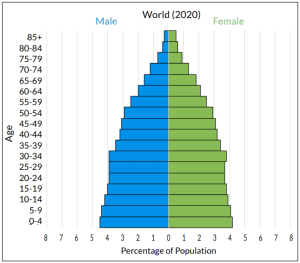This is the second post in a three-part series about exponential growth and doubling time. This post will explore the concept of doubling time and explain how one can calculate the doubling time for a population growing exponentially using the rule of 70.
What is Doubling Time?
Doubling time is the amount of time it takes for a given quantity to double in size or value at a constant growth rate. We can find the doubling time for a population undergoing exponential growth by using the Rule of 70. To do this, we divide 70 by the growth rate (r).
Note: growth rate (r) must be entered as a percentage and not a decimal fraction. For example 5% must be entered as 5 instead of 0.05.
dt = 70/r
For example, a population with a 2% annual growth would have a doubling time of 35 years.
35 = 70/2
Key Properties of Doubling Time
- The larger the rate of growth (r), the faster the doubling time.
- Rate of growth varies considerably among organisms. For example, most small bodied organisms grow faster and have larger rates of population increase than larger organisms. Think about the difference in growth rate between bacteria and elephants.
- Most populations cannot double forever. Resistance factors like natural resource constraints and disease contribute to a leveling off in population size over time. When this happens, we say the population has reached its carrying capacity. This type of growth is also referred to as logistic growth.
Resources for Teaching Students about Doubling Time
- Double Trouble: A secondary activity (grades 9-12) exploring the concepts of exponential growth and doubling time. Students observe and collect data on the exponential growth of yeast cultures in both a lab experiment and under a microscope, graphing their findings and comparing their results with human population growth.
Exponential Growth Series
- Post 1: What is Exponential Growth?
- Post 2: What is Doubling Time and How is it Calculated?
- Post 3: Using Population Growth to Explore Exponential Growth and Doubling Time




